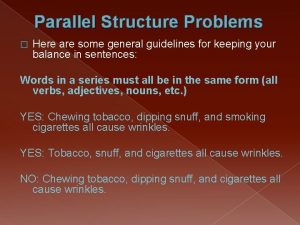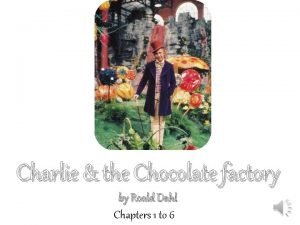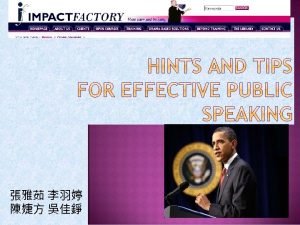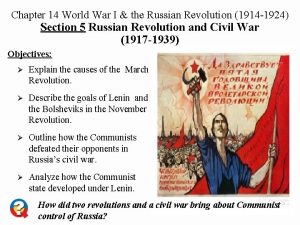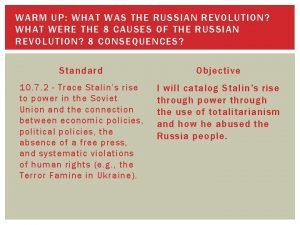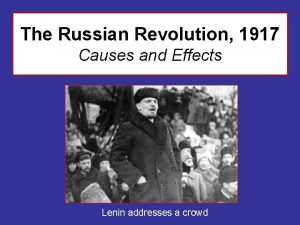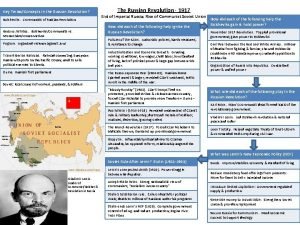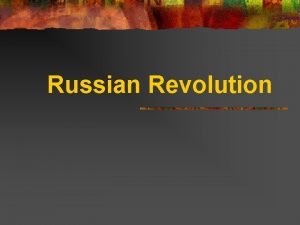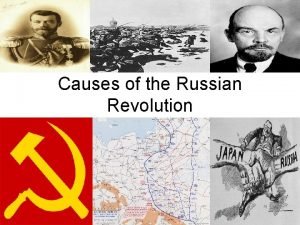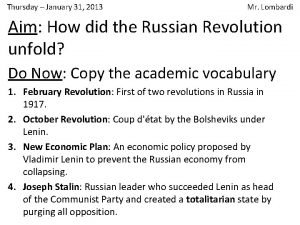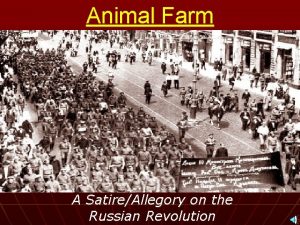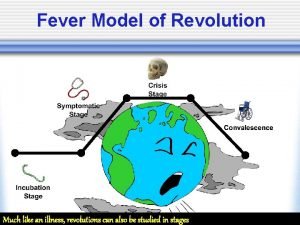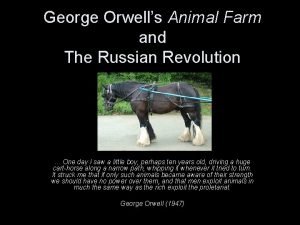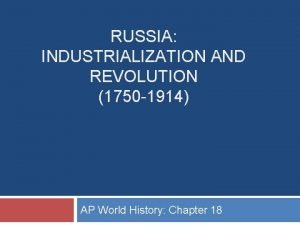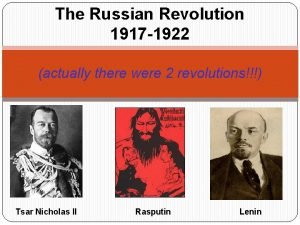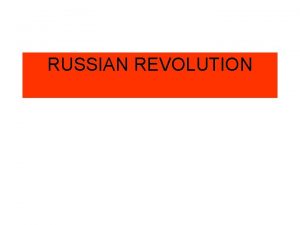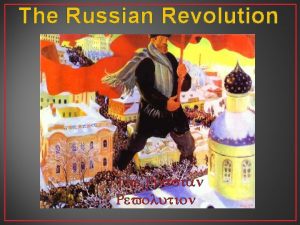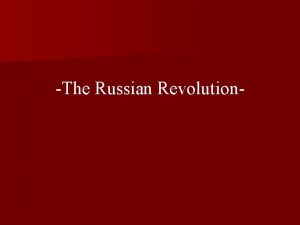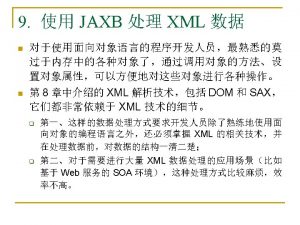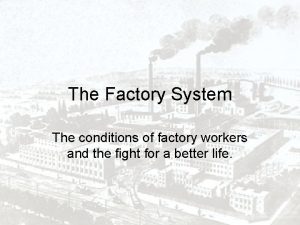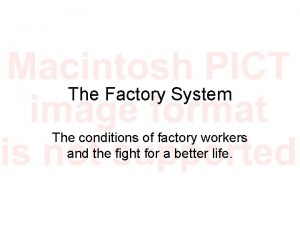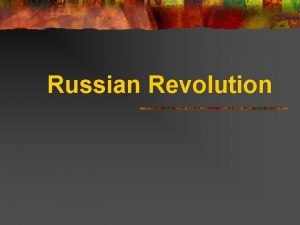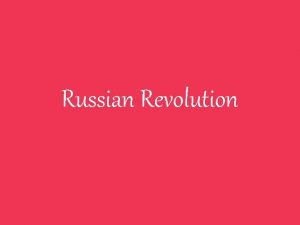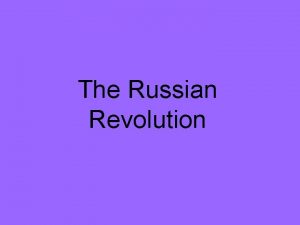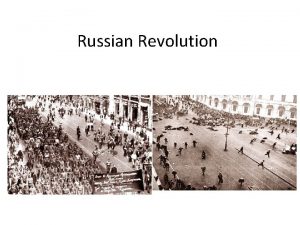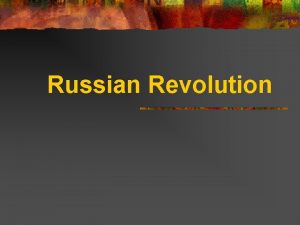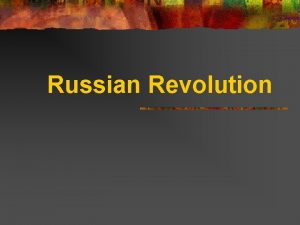Russian Revolution Prelude to the Revolution Factory workers





















- Slides: 21

Russian Revolution

Prelude to the Revolution • Factory workers and peasants lived in terrible poverty, while wealthy landowning nobles enjoyed lives of wealth and leisure. • The autocratic Tsars (Czars) Alexander III (late 1800 s) and his son Nicholas II opposed democratic reform, and secret revolutionary societies formed among some of the educational elite.



The Revolution of 1905 • Russia was ripe for a revolution! • The crisis came to a head after their defeat in the Russo. Japanese War (1904 -1905). • When troops shot down unarmed demonstrators ( KNOWN AS BLOODY SUNDAY) in St. Petersburg in 1905.

The Revolution of 1905 • The “October Manifesto” – Czar Nicholas II announces reforms and new freedoms. • Nicholas II finally granted some limited reforms, creating an elected legislature known as the Duma. • However, only the very wealthy could vote for the Duma members.



WWI and Allied Powers • Russia was one of the Allied Powers in WWI. • Russia was not prepared to fight in a modern war. • Many soldiers lacked confidence in Russia’s military leadership and deserted.


The March Revolution • In March 1917, the military defeats sparked a revolt. • Demonstrators demanded bread in the streets of St. Petersburg. The czars soldiers symphonized with the crowds and refused to fire on them. • With no control over his troops Nicholas II abdicates his power.

Failure of Provisional Government • Duma officials set up a temporary government. • Middle-class liberals planned to write a constitution BUT they continued to fight in WWI. • The new government implemented only moderate reforms that did little to end the unrest among the peasants and workers.

The Bolshevik Revolution • Following the March Revolution, an exiled revolutionary named Vladimir Lenin returned home. • Lenin and Leon Trotsky headed a revolutionary socialist party, the Bolsheviks. • Lenin and Trotsky followed the ideas of Karl Marx and adapted them to the Russian situation

The Bolshevik Revolution • Lenin gained support by promising “Peace, Land, and Bread” – An end to the involvement in war. – A promise for land reform. – An end to the food shortages.

Lenin Takes Over • The provisional government lost support of the people. In Nov. 1917, the Bolsheviks led soldiers and workers in an uprising to overthrow the government. • The Bolsheviks, now called Communists – – Distributed land to peasants. – Gave workers control of the factories and mines. The Communists still faced a struggle to maintain control over Russia.

Lenin Rules Russia • Withdraws from WWI – Russia signed the treaty of Brest-Litovisk. The agreement was costly for Russia, giving Germany a large amount of Russian territory. • Lenin believed he needed to make peace with Germany so he could face his enemies at home.

Russia’s Civil War (1918~1921) • Lenin’s Red Army battled the loyal forces to the czar, called the Whites. • Nationalist groups in the Russian Empire also rose up against the Red Army during this time, winning independence for Latvia, Lithuania, Estonia, and Poland. • Nicholas II and his family were executed during this time as brutal tactics were carried out on both sides.

Russia’s Civil War (1918~1921) • Britain, France and the United States all sent troops to help the Whites. • This foreign intervention only helped stir up nationalism and inspire the Red Army. • Trotsky led his inspired group to victory in 1921.

One Party Government • Lenin’s government had a constitution and an elected legislature. However, the Communist party had all the real power. • The Communist Party was the only legal party. • Plus, only it’s members could run for office.

New Economic Policy • During the civil war the Bolsheviks took over the factories, mines, banks, and railroads. • Under the NEP the government still controlled those businesses, but allowed some privately owned businesses. • This helped the economy to recover.

The Soviet Union By 1922, Lenin and the Communists had gained control over much of the old Russian Empire. • The Communist government then created the Union of Soviet Socialist Republics (U. S. S. R. ), also called the Soviet Union. • It was made up of diverse European and Asian peoples. • Russia was the largest republic and controlled the other states in the Soviet Union. •
 Russian revolution vs french revolution
Russian revolution vs french revolution The factory workers were ready able
The factory workers were ready able Here comes charlie chapter 1
Here comes charlie chapter 1 The impact factory
The impact factory Chapter 14 world war 1 and the russian revolution
Chapter 14 world war 1 and the russian revolution Russian revolution effects
Russian revolution effects Causes and effects of the russian revolution
Causes and effects of the russian revolution Triple alliance ap euro
Triple alliance ap euro Russian revolution political cartoons
Russian revolution political cartoons Russian revolution
Russian revolution Http://www.history.com/topics/russian-revolution
Http://www.history.com/topics/russian-revolution Effect of russian revolution
Effect of russian revolution Who lost territory after ww1
Who lost territory after ww1 Causes of the russian revolution
Causes of the russian revolution Summary of animal farm
Summary of animal farm Russian revolution fever model
Russian revolution fever model Animal farm
Animal farm Chapter 27 world war 1 and the russian revolution
Chapter 27 world war 1 and the russian revolution Russian revolution of 1905 definition ap world history
Russian revolution of 1905 definition ap world history How did vladimir lenin influence the russian revolution
How did vladimir lenin influence the russian revolution Russian revolution
Russian revolution In the view of this cartoonist russia under
In the view of this cartoonist russia under

